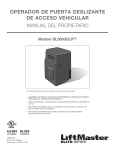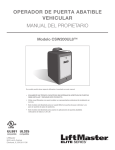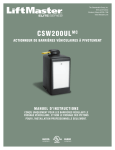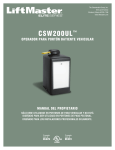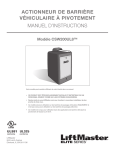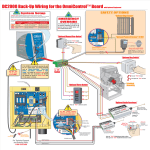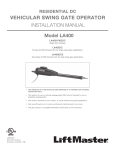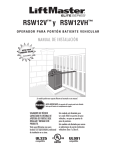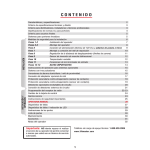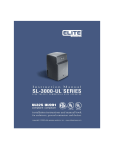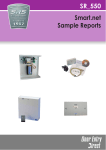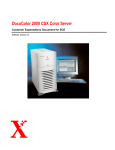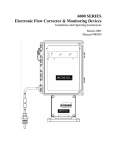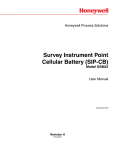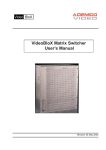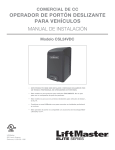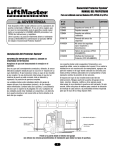Download SL3000UL8 Owner`s Manual
Transcript
VEHICULAR SLIDE GATE OPERATOR OWNER’S MANUAL Model SL3000UL8™ Your model may look different than the model illustrated in this manual. • THIS PRODUCT IS TO BE INSTALLED AND SERVICED BY A TRAINED GATE SYSTEMS TECHNICIAN ONLY. • Visit www.liftmaster.com to locate a professional installing dealer in your area. • This model is for use on vehicular passage gates ONLY and not intended for use on pedestrian passage gates. • This model is intended for use in Class I, II, III and IV vehicular swing gate applications. UL991 UL325 compliant compliant LiftMaster 845 Larch Avenue Elmhurst, IL 60126-1196 TABLE OF CONTENTS SPECIFICATIONS AND WARNINGS 2 TROUBLESHOOTING SL3000UL8™ MODELS OVERVIEW . . . . . . . . . . . . . . . . . . . . . . . . . . . 2 UL325 MODEL CLASSIFICATIONS . . . . . . . . . . . . . . . . . . . . . . . . . . . 3 SAFETY INSTALLATION INFORMATION . . . . . . . . . . . . . . . . . . . . . . . 4 GATE CONSTRUCTION INFORMATION . . . . . . . . . . . . . . . . . . . . . . . . 5 SAFETY INSTALLATION INFORMATION . . . . . . . . . . . . . . . . . . . . . . . 6 WARNING SIGN PLACEMENT . . . . . . . . . . . . . . . . . . . . . . . . . . . . . . . 6 REQUIRED ENTRAPMENT PROTECTION DEVICE LOCATIONS . . . . . . 7 REQUIRED ENTRAPMENT PROTECTION DEVICE LOCATIONS . . . . . . 8 INSTALLATION REPAIR PARTS 9 46 INSTALLATION CHECKLIST 47 WARRANTY POLICY 48 15 Electrical When you see these Safety Symbols and Signal Words on the following pages, they will alert you to the possibility of serious injury or death if you do not comply with the warnings that accompany them. The hazard may come from something mechanical or from electric shock. Read the warnings carefully. When you see this Signal Word on the following pages, it will alert you to the possibility of damage to your gate and/or the gate operator if you do not comply with the cautionary statements that accompany it. Read them carefully. 26 IMPORTANT NOTE: SET GATE OPENING DIRECTION . . . . . . . . . . . . . . . . . . . . . . . . . . . . 26 LIMIT SWITCH ADJUSTMENT . . . . . . . . . . . . . . . . . . . . . . . . . . . . . . 26 RADIO RECEIVER PROGRAMMING . . . . . . . . . . . . . . . . . . . . . . . . . . 27 SETTING TIMER (ON, OFF) . . . . . . . . . . . . . . . . . . . . . . . . . . . . . . . . 28 ADJUSTING REVERSING SENSOR(S) . . . . . . . . . . . . . . . . . . . . . . . . 29 MAINTENANCE AND OPERATION SYSTEM DIAGRAM Mechanical EARTH GROUND ROD INSTALLATION . . . . . . . . . . . . . . . . . . . . . . . 15 120 VAC POWER CONNECTION . . . . . . . . . . . . . . . . . . . . . . . . . . . . 16 HEATER POWER CONNECTION . . . . . . . . . . . . . . . . . . . . . . . . . . . . . 16 LINKING PRIMARY/SECONDARY OPERATORS. . . . . . . . . . . . . . . . . 17 SOLENOID/MAGLOCK RELAY CONNECTION . . . . . . . . . . . . . . . . . . . 18 FACTORY INSTALLED DC2000™ CONNECTION . . . . . . . . . . . . . . . . 19 DC2000™ DEVICE WIRING . . . . . . . . . . . . . . . . . . . . . . . . . . . . . . . . 20 PLUG-IN LOOP DETECTOR WIRING . . . . . . . . . . . . . . . . . . . . . . . . . 21 120 VAC EXTERNAL LOOP DETECTOR WIRING . . . . . . . . . . . . . . . . 22 ENTRAPMENT PROTECTION DEVICES . . . . . . . . . . . . . . . . . . . . . . . 23 ENTRAPMENT PROTECTION DEVICES . . . . . . . . . . . . . . . . . . . . . . . 24 OMNICONTROL™ BOARD CONNECTIONS . . . . . . . . . . . . . . . . . . . . 25 ADJUSTMENTS • BEFORE attempting to install, operate or maintain the operator, you must read and fully understand this manual and follow all safety instructions. • DO NOT attempt repair or service of your gate operator unless you are an Authorized Service Technician. 30 MAINTENANCE . . . . . . . . . . . . . . . . . . . . . . . . . . . . . . . . . . . . . . . . . 30 BUILT-IN RESET SWITCH . . . . . . . . . . . . . . . . . . . . . . . . . . . . . . . . . 31 AUDIO ALARM . . . . . . . . . . . . . . . . . . . . . . . . . . . . . . . . . . . . . . . . . . 31 MANUAL DISCONNECT . . . . . . . . . . . . . . . . . . . . . . . . . . . . . . . . . . . 32 OPTIONAL MANUAL RELEASE . . . . . . . . . . . . . . . . . . . . . . . . . . . . . 32 ACCESSORIES 33 WIRING DIAGRAMS 34 44 REPAIR PARTS ILLUSTRATIONS . . . . . . . . . . . . . . . . . . . . . . . . . . . 44 HOW TO ORDER REPAIR PARTS . . . . . . . . . . . . . . . . . . . . . . . . . . . 45 REPAIR PART NAMES AND NUMBERS . . . . . . . . . . . . . . . . . . . . . . . 45 INSTALLATION SETUPS . . . . . . . . . . . . . . . . . . . . . . . . . . . . . . . . . . . 9 SAFETY CATCH ROLLERS AND GATE RAIL STOPS . . . . . . . . . . . . . 10 MOUNTING OPERATOR . . . . . . . . . . . . . . . . . . . . . . . . . . . . . . . . . . . 11 POST MOUNTING PLATE (OPTIONAL) . . . . . . . . . . . . . . . . . . . . . . . 11 CHAIN INSTALLATION TYPES . . . . . . . . . . . . . . . . . . . . . . . . . . . . . . 12 CHAIN DISTANCE AND HEIGHT ON GATE . . . . . . . . . . . . . . . . . . . . . 12 CONTROL BOARD DESCRIPTION . . . . . . . . . . . . . . . . . . . . . . . . . . . 13 SURGE SUPPRESSOR TERMINAL CONNECTIONS . . . . . . . . . . . . . . 14 WIRING 42 THE GATE WILL NOT OPERATE WITH REMOTE . . . . . . . . . . . . . . . . 42 RESETTING MOTOR(S) . . . . . . . . . . . . . . . . . . . . . . . . . . . . . . . . . . 42 TROUBLESHOOTING CHART . . . . . . . . . . . . . . . . . . . . . . . . . . . . . . . 43 SL3000UL8™ . . . . . . . . . . . . . . . . . . . . . . . . . . . . . . . . . . . . . . . . . . . 34 WIRING TABLE SL3000UL8™ . . . . . . . . . . . . . . . . . . . . . . . . . . . . . . 35 SL3000ULDM8™ . . . . . . . . . . . . . . . . . . . . . . . . . . . . . . . . . . . . . . . . 36 WIRING TABLE SL3000ULDM8™ . . . . . . . . . . . . . . . . . . . . . . . . . . . 37 SL3000UL1HP8™ . . . . . . . . . . . . . . . . . . . . . . . . . . . . . . . . . . . . . . . 38 WIRING TABLE SL3000UL1HP8™ . . . . . . . . . . . . . . . . . . . . . . . . . . . 39 DC2000™ FOR SINGLE AND DM . . . . . . . . . . . . . . . . . . . . . . . . . . . . 40 WIRING TABLE DC2000™ . . . . . . . . . . . . . . . . . . . . . . . . . . . . . . . . . 41 1 SPECIFICATIONS AND WARNINGS SL3000UL8™ MODELS OVERVIEW Single Motor Models Front View SL3000UL8™ (Single Motor) 1/2 HP Motor, 120 Vac, 4 Amp. Maximum Gate Length – 37 ft. Maximum Gate Weight – 1000 lbs. Maximum Pull – 105 lbs. Back View Heater SL3000ULDC8™ (Single Motor) 1/2 HP Motor, DC2000™, 120 Vac, 4 Amp. Maximum Gate Length – 37 ft. Maximum Gate Weight – 1000 lbs. Maximum Pull – 105 lbs. SL3000ULH8™ (Single Motor) 1/2 HP Motor, 120 Vac, 4 Amp., Heater 3 Amp Maximum Gate Length – 37 ft. Maximum Gate Weight – 1000 lbs. Maximum Pull – 105 lbs. Cover SL3000ULDCH8™ (Single Motor) 1/2 HP Motor, DC2000™, 120 Vac, 4 Amp., Heater 3 Amp Maximum Gate Length – 37 ft. Maximum Gate Weight – 1000 lbs. Maximum Pull – 105 lbs. DC2000™ Back-Up All operators come with 2 warning placards and a warranty card. Dual Motor and 1 HP Models SL3000ULDM8™ (Dual Motor) Two -1/2 HP Motors, 120 Vac, 4.7 Amp. Maximum Gate Length – 37 ft. Maximum Gate Weight – 800 lbs. Maximum Pull – 100 lbs. SL3000ULDMDC8™ (Dual Motor) Back View Front View Heater Two -1/2 HP Motors, DC2000™, 120 Vac, 4.7 Amp. Maximum Gate Length – 37 ft. Maximum Gate Weight – 800 lbs. Maximum Pull – 100 lbs. SL3000ULDMH8™ (Dual Motor) Two -1/2 HP Motors, 120 Vac, 4.7 Amp., Heater 3 Amp Maximum Gate Length – 37 ft. Maximum Gate Weight – 800 lbs. Maximum Pull – 100 lbs. SL3000ULDMDCH8™ (Dual Motor) Two-1/2 HP Motors, DC2000™, 120 Vac, 4.7 Amp., Heater 3 Amp Maximum Gate Length – 37 ft. Maximum Gate Weight – 800 lbs. Maximum Pull – 100 lbs. SL3000UL1HP8™ (1 Horse Power) Cover Second Motor DC2000™ Back-Up Dual Motor Only. Two-1/2 HP Motors, 120 Vac, 8.4 Amp. Maximum Gate Length – 37 ft. Maximum Gate Weight – 2000 lbs. Maximum Pull – 180 lbs. NOTE: The 1 HP models cannot have the DC2000™ Battery Backup system. SL3000UL1HPH8™ (1 Horse Power) Two-1/2 HP Motors, 120 Vac, 8.7 Amp., Heater 3 Amp Maximum Gate Length – 37 ft. Maximum Gate Weight – 2000 lbs. Maximum Pull – 180 lbs. 2 SPECIFICATIONS AND WARNINGS UL325 MODEL CLASSIFICATIONS The SL3000UL8™ is intended for use in vehicular slide gate applications: Class I – Residential vehicular gate operator A vehicular gate operator (or system) intended for use in a home of one-to four single family dwellings, or a garage or parking area associated therewith. Class II – Commercial/General access vehicular gate operator A vehicular gate operator (or system) intended for use in a commercial location or building such as a multi-family housing unit (five or more single family units) hotel, garage, retail store or other building servicing the general public. Class III – Industrial/limited access vehicular gate operator A vehicular gate operator (or system) intended for use in a industrial location or building such as a factory or loading dock area or other location not intended to service the general public. Class IV – Restricted access vehicular gate operator A vehicular gate operator (or system) intended for use in a guarded industrial location or building such as an airport security area or other restricted access locations not servicing the general public, in which unauthorized access is prevented via supervision by security personnel. UL325 ENTRAPMENT PROTECTION REQUIREMENTS This chart illustrates the entrapment protection requirements for each of the four UL325 classes. In order to complete a proper installation you must satisfy the entrapment protection chart shown. That means that the installation must have one primary means of entrapment protection and one independent secondary means of entrapment protection. Both primary and secondary entrapment protection methods must be designed, arranged or configured to protect against entrapments in both the open and close directions of gate travel. For Example: For a gate system that is installed on a singlefamily residence (UL325 Class I) you must provide the following: • Type A - Inherent (built into the operator) entrapment sensing and at least one of the following as your secondary entrapment protection: • Type B1 - Non-contact sensors such as photo-eyes or • Type B2 - Contact sensors such as gate edges GATE OPERATOR ENTRAPMENT PROTECTION UL325 Installation Classification Slide Gate Operator Primary Type Secondary Type Class I - Class IV A B1 or B2 NOTE: UL requires that all installations must have warning signs placed in plain view on both sides of the gate to warn pedestrians of the dangers of motorized gate systems. 3 SPECIFICATIONS AND WARNINGS SAFETY INSTALLATION INFORMATION 1. Vehicular gate systems provide convenience and security. Gate systems are comprised of many component parts. The gate operator is only one component. Each gate system is specifically designed for an individual application. 2. Gate operating system designers, installers and users must take into account the possible hazards associated with each individual application. Improperly designed, installed or maintained systems can create risks for the user as well as the bystander. Gate systems design and installation must reduce public exposure to potential hazards. 3. A gate operator can create high levels of force in its function as a component part of a gate system. Therefore, safety features must be incorporated into every design. Specific safety features include: • Gate Edges • Guards for Exposed Rollers • Photoelectric Sensors • Screen Mesh • Vertical Posts • Instructional and Precautionary Signage 4. Install the gate operator only when: a. The operator is appropriate for the construction and the usage class of the gate. b. All openings of a horizontal slide gate are guarded or screened from the bottom of the gate to a minimum of 4' (1.2 m) above the ground to prevent a 2-1/4" (6 cm) diameter sphere from passing through the openings anywhere in the gate, and in that portion of the adjacent fence that the gate covers in the open position. c. All exposed pinch points are eliminated or guarded, and guarding is supplied for exposed rollers. 5. The operator is intended for installation only on gates used for vehicles. Pedestrians must be supplied with a separate access opening. The pedestrian access opening shall be designed to promote pedestrian usage. Locate the gate such that persons will not come in contact with the vehicular gate during the entire path of travel of the vehicular gate. 6. The gate must be installed in a location so that enough clearance is supplied between the gate and adjacent structures when opening and closing to reduce the risk of entrapment. Swinging gates shall not open into public access areas. 7. The gate must be properly installed and work freely in both directions prior to the installation of the gate operator. 8. Controls intended for user activation must be located at least six feet (6') away from any moving part of the gate and where the user is prevented from reaching over, under, around or through the gate to operate the controls. Outdoor or easily accessible controls shall have a security feature to prevent unauthorized use. 9. The Stop and/or Reset (if provided separately) must be located in the line-of-sight of the gate. Activation of the reset control shall not cause the operator to start. 10. A minimum of two (2) WARNING SIGNS shall be installed, one on each side of the gate where easily visible. 11. For a gate operator utilizing a non-contact sensor: a. Reference owner’s manual regarding placement of non-contact sensor for each type of application. b. Care shall be exercised to reduce the risk of nuisance tripping, such as when a vehicle trips the sensor while the gate is still moving. c. One or more non-contact sensors shall be located where the risk of entrapment or obstruction exists, such as the perimeter reachable by a moving gate or barrier. 12. For a gate operator utilizing a contact sensor such as an edge sensor: a. One or more contact sensors shall be located where the risk of entrapment or obstruction exists, such as at the leading edge, trailing edge and post mounted both inside and outside of a vehicular horizontal slide gate. b. One or more contact sensors shall be located at the bottom edge of a vehicular vertical lift gate. c. A hard wired contact sensor shall be located and its wiring arranged so the communication between the sensor and the gate operator is not subject to mechanical damage. d. A wireless contact sensor such as the one that transmits radio frequency (RF) signals to the gate operator for entrapment protection functions shall be located where the transmission of the signals are not obstructed or impeded by building structures, natural landscaping or similar obstruction. A wireless contact sensor shall function under the intended end-use conditions. e. One or more contact sensors shall be located on the inside and outside leading edge of a swing gate. Additionally, if the bottom edge of a swing gate is greater than 6" (152 mm) above the ground at any point in its arc of travel, one or more contact sensors shall be located on the bottom edge. f. One or more contact sensors shall be located at the bottom edge of a vertical barrier (arm). 4 SPECIFICATIONS AND WARNINGS GATE CONSTRUCTION INFORMATION Vehicular gates should be installed in accordance with ASTM F2200: Standard Specification for Automated Vehicular Gate Construction. For a copy, contact ASTM directly at 610-832-9585 or www.astm.org. 1. General Requirements 1.1 Gates shall be constructed in accordance with the provisions given for the appropriate gate type listed, refer to ASTM F2200 for additional gate types. 1.2 Gates shall be designed, constructed and installed to not fall over more than 45 degrees from the vertical plane, when a gate is detached from the supporting hardware. 1.3 Gates shall have smooth bottom edges, with vertical bottom edged protrusions not exceeding 0.50 inches (12.7 mm) when other than the exceptions listed in ASTM F2200. 1.4 The minimum height for barbed tape shall not be less than 8 feet (2.44 m) above grade and for barbed wire shall not be less than 6 feet (1.83 m) above grade. 1.5 An existing gate latch shall be disabled when a manually operated gate is retrofitted with a powered gate operator. 1.6 A gate latch shall not be installed on an automatically operated gate. 1.7 Protrusions shall not be permitted on any gate, refer to ASTM F2200 for Exceptions. 1.8 Gates shall be designed, constructed and installed such that their movement shall not be initiated by gravity when an automatic operator is disconnected. 1.9 A pedestrian gate shall not be incorporated into a vehicular gate panel or that portion of the adjacent fence that the gate covers in the open position. 3.1.3 A gap, measured in the horizontal plane parallel to the roadway, between a fixed stationary object nearest the roadway, (such as a gate support post) and the gate frame when the gate is in either the fully open position or the fully closed position, shall not exceed 2-1/4 inches (57 mm), refer to ASTM F2200 for Exception. 3.1.4 Positive stops shall be required to limit travel to the designed fully open and fully closed positions. These stops shall be installed at either the top of the gate, or at the bottom of the gate where such stops shall horizontally or vertically project no more than is required to perform their intended function. 3.1.5 All gates shall be designed with sufficient lateral stability to assure that the gate will enter a receiver guide, refer to ASTM F2200 for panel types. 3.2 The following provisions shall apply to Class IV vehicular horizontal slide gates: 3.2.1 All weight bearing exposed rollers 8 feet (2.44 m), or less, above grade shall be guarded or covered. 3.2.2 Positive stops shall be required to limit travel to the designed fully open and fully closed positions. These stops shall be installed at either the top of the gate, or at the bottom of the gate where such stops shall horizontally or vertically project no more than is required to perform their intended function. 2. Specific Applications 2.1 Any non-automated gate that is to be automated shall be upgraded to conform to the provisions of this specification. 2.2 This specification shall not apply to gates generally used for pedestrian access and to vehicular gates not to be automated. 2.3 Any existing automated gate, when the operator requires replacement, shall be upgraded to conform to the provisions of this specification in effect at that time. 4. Vehicular Horizontal Swing Gates 4.1 The following provisions shall apply to Class I, Class II and Class III vehicular horizontal swing gates: 4.1.1 Gates shall be designed, constructed and installed so as not to create an entrapment area between the gate and the supporting structure or other fixed object when the 3. Vehicular Horizontal Slide Gates gate moves toward the fully open position, subject to the provisions in the 4.1.1.1 and 4.1.1.2. 3.1 The following provisions shall apply to Class I, Class II and Class III vehicular horizontal slide gates: 4.1.1.1 The width of an object (such as a wall, pillar or column) covered by a swing gate when in the open position shall 3.1.1 All weight bearing exposed rollers 8 feet (2.44 m), or less, not exceed 4 inches (102 mm), measured from the above grade shall be guarded or covered. center line of the pivot point of the gate, refer to ASTM F2200 for exception. 3.1.2 All openings located between 48 inches (1.22 m) and 72 inches (1.83 m) above grade shall be designed, guarded or 4.1.1.2 Except for the zone specified in Section 4.1.1.1, the screened to prevent a 4 inch (102 mm) diameter sphere from distance between a fixed object such as a wall, pillar or passing through the openings anywhere in the gate, and in column, and a swing gate when in the open position that portion of the adjacent fence that covers in the open shall not be less than 16 inches (406 mm), refer to position. ASTM F2200 for exception. 4.2 Class IV vehicular horizontal swing gates shall be designed, constructed and installed in accordance with security related parameters specific to the application in question. 5 SPECIFICATIONS AND WARNINGS SAFETY INSTALLATION INFORMATION THE SL3000UL8™ IS FOR USE ON VEHICULAR PASSAGE GATES ONLY AND NOT INTENDED FOR USE ON PEDESTRIAN PASSAGE GATES. To prevent SERIOUS INJURY or DEATH from a moving gate: • Entrapment protection devices MUST be installed to protect anyone who may come near a moving gate. • Locate entrapment protection devices to protect in BOTH the open and close gate cycles. • Locate entrapment protection devices to protect between moving gate and RIGID objects, such as posts or walls. Property owners MUST never mount any gate operating device near the gate's path! Property owners MUST never allow anyone to hang or ride on the gate! Property owners MUST never let pedestrians cross the path of a moving gate! WARNING SIGN PLACEMENT To prevent SERIOUS INJURY or DEATH from a moving gate: Install Warning signs on BOTH sides of EACH gate, in PLAIN VIEW. 6 SPECIFICATIONS AND WARNINGS REQUIRED ENTRAPMENT PROTECTION DEVICE LOCATIONS To prevent SERIOUS INJURY or DEATH from a moving gate: • Entrapment protection devices MUST be installed to protect anyone who may come near a moving gate. • Locate entrapment protection devices to protect in BOTH the open and close gate cycles. • Locate entrapment protection devices to protect between moving gate and RIGID objects, such as posts or walls. Non-Contact Sensors (Photoelectric Sensors) Install photoelectric sensors to protect against any entrapment or safety conditions encountered in your gate application. See Entrapment Protection Devices. Safety loops allow the gate to stay open when vehicles are obstructing the gate path. Suggested for vehicles 14 feet or longer. See Loop Detector Wiring. er g an D e l t en Cyc m p N tra OPE n E or f Gate Rail Stops For safety reasons, physical stops MUST be installed on both ends of the gate rail prior to installation of the gate operator. This will assure that the gate does not derail while opening or closing fully. y ert e sid Out p Pro y ert ide Ins p Pro y ert ide s Out p Pro r ge e n a cl y D Cy t fe SE Sa LO rC fo rty ide Ins 7 pe Pro SPECIFICATIONS AND WARNINGS REQUIRED ENTRAPMENT PROTECTION DEVICE LOCATIONS To prevent SERIOUS INJURY or DEATH from a moving gate: • Entrapment protection devices MUST be installed to protect anyone who may come near a moving gate. • Locate entrapment protection devices to protect in BOTH the open and close gate cycles. • Locate entrapment protection devices to protect between moving gate and RIGID objects, such as posts or walls. Contact Sensors (Edge Sensors) Install edge sensors to protect against any entrapment or safety conditions encountered in your gate application. See Entrapment Protection Devices. Gate Rail Stops For safety reasons, physical stops MUST be installed on both ends of the gate rail prior to installation of the gate operator. This will assure that the gate does not derail while opening or closing fully. Safety loops allows the gate to stay open when vehicles are obstructing the gate path. Suggested for vehicles 14 feet or longer. See Loop Detector Wiring. Edge sensor for open cycle on wall. Edge sensor for open cycle on gate. Edge sensor for open cycle on wall. Edge sensor for close cycle on wall. y ert e id uts p Pro Edge sensor for close cycle on gate. er nt r e apm Ent O er ty e Saf g Dan ty de nsi I 8 P er p o r g Dan INSTALLATION INSTALLATION SETUPS Front or Rear Position with Single Operator UL approved catch roller with safety cover. 2 inch wire grid safety screen 48 inches high. Front Position Low Voltage UL approved conduit High Voltage UL approved conduit Maximum gate length 37 ft. Maximum gate length with long gate kit: 51 ft. Concrete Pad Maximum gate weight varies for operators. UL approved catch roller with safety cover. Warning Placard on both sides of gate. Rear Position Idler pulley MUST have safety cover. Earth Ground is highly recommended. Use the proper type earth ground rod for your area. Weld physical stops on ends of gate rail. Primary/Secondary Operators UL approved catch rollers with safety covers. Maximum gate length 37 ft. for each gate. Maximum gate weight varies for operators. Separate power supply for each operator. Warning Placard on both sides of each gate. 2 inch wire grid safety screen 48 inches high. Low Voltage UL approved conduit High Voltage UL approved conduit Earth Ground is highly recommended for each operator. Use the proper type earth ground rod for your area. 9 Weld physical stops on ends of gate rail. Concrete Pad INSTALLATION SAFETY CATCH ROLLERS AND GATE RAIL STOPS DO NOT use a Gate Catch Post. Because the coasting distance may vary due to changes in temperature, it is NOT recommended to install a stop or catch post in front of the gates path. To do so will cause the gate to hit the post in certain instances. Safety Catch Rollers ate gG in los te C g sin Ga Clo Gate Rail Stop It is only recommended installing catch rollers with safety covers on the side of a post or wall with a minimal distance of half an inch between the rollers and gate. When fully opened, the end of the sliding gate should stop at least five inches from an obstructing wall. 1/2" 1/2" 5" End View of Gate and Wall NOTE: For safety reasons, physical stops MUST be installed on both ends of the gate rail prior to installation of the gate operator. This will assure that the gate does not derail while opening or closing fully. 10 INSTALLATION MOUNTING OPERATOR Suggested installation for dirt ground. The measurements depend on the type of ground (ie., asphalt, cement, dirt). Check local building codes before installation. Top Inside View Conduit area without battery back-up. 8.25" 13" High voltage conduit. 4 Concrete Anchors 1/2" x 3 1/2" Above Ground Low voltage conduit. 6" 10" 10.4" Below the frost line. Check all local codes. 10.3" Co nc re te Op M tio or Pa ou n d a (S ntin l P ee g os be Pl t lo ate w 24" ) POST MOUNTING PLATE (OPTIONAL) Post Mounting Plate 3" heavy steel posts can be U-bolted to mounting plate and cemented in ground. Power and control wiring should be run in separate conduits. 11 8" Concrete (Reinforced Recommended) 24" INSTALLATION CHAIN INSTALLATION TYPES Drawings not to scale To reduce the risk of SERIOUS INJURY or DEATH, make sure exposed idler pulleys have safety covers on them. Front Operator Position Weld rear bracket with gate in closed position Weld front bracket with gate in open position. Horizontal Alignment Rear Operator Position Cut the chain slot 17 1/2" high on cover. Low idler pulley position. CHAIN DISTANCE AND HEIGHT ON GATE Correct Installation Don’t connect chain too tight to gate. Incorrect Installation 2 inch wire grid safety screen is missing. Chain is mounted too high or too low on gate. Chain is too loose on gate. Gate is 4 inches minimum distance away from drive sprocket and parallel to gate. Operator is mounted too close and not parallel to gate. Top View of Gate Top View of Gate Over time, the gate’s chain will stretch out and need to have links removed from it. The links can be removed during normal periodic maintenance of the operator. 12 INSTALLATION CONTROL BOARD DESCRIPTION Plug-In Loop Detectors 1 HP Board Not Used Maglock/Solenoid Relay Module Connection UL Alarm Connection Surge Suppressor Primary/Secondary Connection Photoelectric Sensor Connection W4 Jumper Wire Plug-In Loop Wires OmniControl™ Board Connection 1. 1HP Connection - Factory installed SL3000UL1HP8™ Models. 13. Strike Open LED - Strike connected device activated when ON. 2. J3 Motor, Limit Switch, Maglock/Solenoid Connection 3. DC2000™ Back-Up Power or Reset Switch/Interlock Connection 14. Safety Loop LED - Safety loop detector activated when ON. 4. Circuit Board Power LED - Operator power OK when ON. 16. Exit Loop LED - Exit loop detector activated when ON. 5. Overload LED - Operator power has overloaded when ON. 17. Command Processed LED - Successful command executed. 6. On-Board 3 Button Station - Close, Stop, Open commands. 18. Alarm Sensor - Limited Adjustment. 7. Timer - Timed close. 19. Reverse Sensor - Gate hit obstruction when ON. 8. Gate Opening Direction Selector - Open Left, Open Right. 9. Gate Locked LED - Maglock/Solenoid is activated when on. 20. System On LED - Operator is successfully performing a command. 15. Fire Dept LED - Key Switch activated when ON. 10. Reset Motor LED - Cycle operator power when ON. 21. J1 Surge Suppressor Data Connection 11. Radio Receiver LED- Radio transmitter is activated when ON. 22. M/S Link LED - Data being transferred between primary and secondary operators when ON. 12. Center Loop LED - Center loop detector activated when ON. 13 Primary/Secondary Connection SURGE SUPPRESSOR TERMINAL CONNECTIONS Output Power Ground 24 Vdc 120 Vac Power Removable Terminals To ENSURE proper operation of external devices: • ENSURE bare wires make good contact inside removable terminal connections. • DO NOT let wire insulation interfere with connection. OR Remote NOT Included Second Operator Link Separate Power 315 MHz Factory Installed Radio Receiver Card Reader Separate power for card reader. External 120 Vac “Safety” Loop Detector Separate Power Push Button Dry Contact External 120 Vac “Exit” Loop Detector Telephone Entry System 12 Vdc Failsafe Photoelectric Sensor Separate power for TES. NOTE: Terminals 11 and 12 are the ONLY terminals that will Open and Close with a single push of a button. All other terminals will ONLY Open with a single push of a button. Fire or any Key Switch Dry Contact 14 WIRING To reduce the risk of SEVERE INJURY or DEATH: • ANY maintenance to the operator or in the area near the operator MUST NOT be performed until disconnecting the electrical power and locking-out the power. Upon completion of maintenance the area MUST be cleared and secured, at that time the unit may be returned to service. • Disconnect power at the fuse box BEFORE proceeding. Operator MUST be properly grounded and connected in accordance with local electrical codes. NOTE: The operator should be on a separate fused line of adequate capacity. • ALL electrical connections MUST be made by a qualified individual. 120 Vac Power Wire 16 Gauge 1/2 HP and Dual Motor 14 Gauge up to 150 FT 250 FT 1 HP up to 75 FT 125 FT • DO NOT install ANY wiring or attempt to run the operator without consulting the wiring diagram. We recommend that you install an optional reversing edge BEFORE proceeding with the control station installation. • ALL power wiring should be on a dedicated circuit and well protected. The location of the power disconnect should be visible and clearly labeled. • ALL power and control wiring MUST be run in separate conduit. • BEFORE installing power wiring or control stations be sure to follow ALL specifications and warnings described below. Failure to do so may result in SEVERE INJURY to persons and/or damage to operator. • DO NOT disconnect the built-in audio alarm or reset switch. 12 Gauge 10 Gauge 8 Gauge 4 Gauge 400 FT 650 FT 1000 FT 2200 FT 200 FT 325 FT 500 FT 1100 FT All power wiring should be on a dedicated circuit and well protected. NOTE: Calculated using NEC guidelines. Local codes and conditions must be reviewed for suitability of wire installation. EARTH GROUND ROD INSTALLATION Proper grounding gives an electrical charge, such as from an electrical static discharge or a near lightning strike, a path from which to dissipate its energy safely into the earth. To AVOID damaging gas, power, or other underground utility lines, contact underground utility locating companies BEFORE digging. Without this path, the intense energy generated by lightning could be directed towards the gate operator. Although nothing can absorb the tremendous power of a direct lightning strike, proper grounding can protect the gate operator in most cases. The earth ground rod must be located within 3 feet from the gate operator. Use the proper type earth ground rod for your local area. The ground wire must be a single, whole piece of wire. Never splice two wires for the ground wire. If you should cut the ground wire too short, break it, or destroy its integrity, replace it with a single wire length. 3 Feet Single piece of 12 gauge wire. Check local codes for proper depth. 15 WIRING 120 VAC POWER CONNECTION Green Ground Connect the black, white and ground wire from the junction box to the 120 Vac power supply. Black 120 Vac Green Ground White Neutral On-Off switch for operator. Green Ground Use a 20 amp dedicated circuit for each operator. Input power 120 Vac, 60 Hz. Earth Ground Rod Highly Recommended! See previous page. Power supply in waterproof conduit. 120 Vac Power Wire 16 Gauge 14 Gauge 12 Gauge 10 Gauge 8 Gauge 4 Gauge 1/2 HP and Dual Motor up to 150 FT 250 FT 400 FT 650 FT 1000 FT 2200 FT 1 HP up to 75 FT 125 FT 200 FT 325 FT 500 FT 1100 FT HEATER POWER CONNECTION Connect the black, white and ground wire from the heater to the 120 Vac power supply as shown. When the heater switch is left in the “ON” position, the heater will turn on and off automatically when needed. To reduce the risk of SERIOUS INJURY: DO NOT touch the heater when switch is on, heater may be hot. Green Wires Ground Black Wires 120 Vac Switch should left in the “ON” position. White Wires Neutral Green Wire Ground Power Supply Green Wire Ground 16 WIRING LINKING PRIMARY/SECONDARY OPERATORS Use a 20 amp dedicated power circuit for each operator. Never run high voltage and low voltage wires in same conduit. Run low voltage 16-18 gauge wire in UL approved conduit to link operators together. EXIT DC-BACKUP SENSOR ALARM CENTER SAFETY Use shielded twisted wires for M/S link. Shield wire MUST be grounded to primary operator Only. EXIT DC-BACKUP W4 STRIKE OPEN RADIO RECEIVER GATE LOCKED EXIT LOOP SAFETY LOOP CENTER LOOP RESET MOTOR – G B A M/S Link Shield Wire Center Loop Safety Loop Exit Loop Fire Dept Key Switch Strike Open Push Button 1 3 OPEN LEFT OPEN RIGHT FIRE DEPT. STRIKE OPEN RADIO RECEIVER GATE LOCKED EXIT LOOP SAFETY LOOP CENTER LOOP RESET MOTOR P/N Q410 OmniControl Surge SuppressorPatent Pending + – G Radio Receiver CHASSIS GROUND Connect Primary M/S Link G to Second M/S Link G. Connect Primary M/S Link B to Second M/S Link B. Connect Primary M/S Link A to Second M/S Link A. POWER OVERLOAD 3 OPEN ALARM SENSOR NOTE: To adjust timers, see page 28. P/N Q410 OmniControl Surge SuppressorPatent Pending 3 3 1 STOP COMMAND PROCESSED CENTER SAFETY FIRE DEPT. 1 COMMAND PROCESSED OPEN RIGHT 60 ON OFF EXIT OPEN LEFT TIMER SENSORS CENTER SAFETY 3 SYSTEM ON MS LINK POWER OVERLOAD 3 OPEN 1 REVERSE SENSOR ALARM SENSOR 3 3 1 EXIT 1 60 ON OFF CLOSE TIMER SENSORS STOP SYSTEM ON MS LINK G B A CLOSE G B A CHASSIS GROUND CENTER SAFETY REVERSE SENSOR W4 Surge Suppressor Primary/ Secondary Connection Secondary Board Primary/Secondary control boards are interchangeable. SENSOR ALARM Primary Board B M/S Link A Center Loop Safety Loop Exit Loop Fire Dept Key Switch Strike Open Push Button + Radio Receiver NOTE: Disconnect the second radio receiver when using a primary/secondary setup. Partial Primary/Individual Control In order for the following operation to occur, follow the instructions. EXAMPLE: There is a double gate, the entry gate is to be opened with a radio transmitter and the exit gate with a free exit loop. Only one safety loop system is to open both gates, and a fire department switch should open both gates at the same time. 1. Connect the radio receiver to entry gate only. 2. Connect the exit loop to exit gate only. 3. Connect the safety loop to both entry and exit gates. Plug-in loop detectors not applicable (Observe polarity of voltage). 4. Connect the fire department switch to both entry and exit gates (Observe polarity of both operators). 17 WIRING SOLENOID/MAGLOCK RELAY CONNECTION Connection of a solenoid or magnetic lock can be made using the J7 board connector and “Optional” Relay Adapter Module. To OmniControl™ Board Solenoid Lock Solenoid Lock Ground Common Plug-In Transformer Normally Closed Optional Relay Adapter Module CENTER SAFETY EXIT Relay Module LEDs Power Relay Light On: Indicates J7 actuation of OmniControl™ board DC-BACKUP SENSOR ALARM Ground W4 TIMER 3 OPEN LEFT OPEN RIGHT COMMAND PROCESSED CENTER SAFETY FIRE DEPT. STRIKE OPEN RADIO RECEIVER GATE LOCKED EXIT LOOP SAFETY LOOP CENTER LOOP RESET MOTOR Relay Contact Rating 2 Amp - 125 AC/DC 2 Amp switching load capability OPEN 1 Magnetic Lock POWER OVERLOAD To OmniControl™ Board 3 Magnetic Lock STOP 3 3 1 ON EXIT 1 60 OFF CLOSE SYSTEM ON SENSORS ALARM SENSOR MS LINK REVERSE SENSOR G B A Power Light On: Indicates power is being received Ground Plug-In Transformer Common Power Ground 18 Normally Open Optional Relay Adapter Module WIRING FACTORY INSTALLED DC2000™ CONNECTION DC2000™ Startup 1. Plug in the 12 pin plug into the DC2000™ control unit. Make sure the “System ON” and “Charge OK” LEDs are lit. If the “Battery Low” led comes on, the battery needs to charge before it can be used. 2. Make sure “Gate Direction” setting on DC2000™ is set the same as the OmniControl™ board setting. See Adjustments. 3. Adjust “Reverse Sensor” setting. See Adjustment Reversing Sensor(s). Reset button and interlock wires, Do Not Remove. 120 Vac Power Failure 120 Vac Power On, OmniControl™ Board Malfunction Manual Mode Push and Hold to operate gate. Turn the 120 Vac power off then push and Hold to operate gate. Auto Mode Gate automatically opens. Turn the 120 Vac power off then gate opens automatically. NOTE: All devices wired to the DC2000™ MUST be dedicated to it alone. Normal operation will be controlled by separate devices wired to the OmniControl™ board and surge suppressor. EXAMPLE: If the DC2000™ is “automatically opening” the gate due to a power failure (auto mode), any manual command such as “One-Button”, “Three Push Button”, “Key Switch”, “Photoelectric Sensor” or “Edge Sensor” will cancel the automatic mode of the DC2000™. After such cancellation, the DC2000™ will continue to operate in “manual mode” until 120 Vac power is restored. 19 WIRING DC2000™ DEVICE WIRING Manually Operated DC2000™ Devices Manual external devices should be dry-contact which do not consume any current like push buttons or a key switch. Key switch is for property owner’s emergency access ONLY. DO NOT USE FOR AN EMERGENCY FIRE/POLICE KEY ACCESS. Contact your local Fire/Police municipalities for more information on correct Fire/Police emergency key access. Manual 3-Button Push and HOLD a button to operate. Manual One-Button Push and HOLD button to Open. Push button again and HOLD to Close. Reset button and interlock wires, Do Not Remove. Manual Key Switch N.O. Com N.O. Com N.O. Com Turn and HOLD key to Open. Turn key again and HOLD to Close. DC2000™ Entrapment Protection Devices It is recommended using separate entrapment protection devices to maintain gate safety when the DC2000™ is needed for any reason. The entrapment protection devices connected to the OmniControl™ board and surge suppressor WILL NOT protect the gate when there is a AC power failure and the DC2000™ is used. (See Accessories for part number) EXIT DC-BACKUP W4 TIMER 60 3 3 1 OFF OPEN LEFT COMMAND PROCESSED CENTER SAFETY POWER OVERLOAD 3 ON OPEN RIGHT FIRE DEPT. STRIKE OPEN RADIO RECEIVER GATE LOCKED EXIT LOOP SAFETY LOOP CENTER LOOP RESET MOTOR OPEN 1 POWER OVERLOAD STOP 3 EXIT 1 CLOSE SYSTEM ON SENSORS ALARM SENSOR MS LINK REVERSE SENSOR G B A DC-BACKUP SENSOR ALARM SAFETY SENSOR ALARM CENTER 3 Edge Sensor OmniControl™ Board Sensor Connection +12 Vdc 123 456 7 Ground 12 Vdc Failsafe Photoelectric Sensor Failsafe Photoelectric Sensor: If a photoelectric sensor is not working, loses power or photoelectric sensor is blocked, then the photoelectric sensor will stop all gate operation. 20 WIRING PLUG-IN LOOP DETECTOR WIRING Plug-In Loop Detectors See Accessories CENTER SAFETY EXIT DETECT LOOP FAIL FREQUENCY SENSITIVITY BOOST DC-BACKUP SENSOR ALARM Not Used POWER ON W4 TIMER 3 OFF OPEN LEFT ON OPEN RIGHT COMMAND PROCESSED CENTER SAFETY The wire MUST be twisted together minimum 6 twists per foot from the end of the loop to the control board. FIRE DEPT. STRIKE OPEN RADIO RECEIVER GATE LOCKED EXIT LOOP SAFETY LOOP CENTER LOOP RESET MOTOR OPEN 1 POWER OVERLOAD 3 STOP 3 3 1 EXIT 1 60 CLOSE SYSTEM ON SENSORS ALARM SENSOR MS LINK REVERSE SENSOR G B A Series Connected To AVOID damaging control board, disconnect ALL power to operator before installing plug-in loop detectors. Use a different frequency for every loop detector installed. Outside Safety Loop Plug-In “Safety” Loop Detector - Allows gate to stay open when vehicles are obstructing path. CAUTION: Suggested for vehicles 14 feet or longer. If the “Inside” and “Outside” safety loops are connected to the same loop detector: • They should be series connected to the detector. • Have the same dimensions. • Have the same number of wire turns. Example of a inside and outside 2 wire turn loop connected in series. (See “Installing Insulated Loop Wire” on next page for more information) Inside Safety Loop Exit Loop NOTE: Refer to the plug-in loop detector manual for more specific information. u PrO op tsid ert e y Plug-In “Exit” Loop Detector - Allows gate to automatically open for exiting vehicles. Example of a 3 wire turn loop. (See “Installing Insulated Loop Wire” on next page for more information.) e id ty s er In p ro P Contact your local dealer for information about plug-in loop detectors. 21 WIRING 120 VAC EXTERNAL LOOP DETECTOR WIRING OmniControl Surge Suppressor G B A 1 2 3 4 5 6 P/N Q410 Patent Pending 7 8 9 10 11 12 13 – u PrO op tsid ert e y G B A Center Loop M/S Link Safety Loop Exit Loop Fire Dept Key Switch Strike Open Push Button + Radio Receiver ey id t s er In p ro P See Accessories 120 Vac “Safety” Loop Detector - Allows gate to stay open when vehicles are obstructing path. CAUTION: Suggested for vehicles 14 feet or longer. If a vehicle is shorter, a center loop system is recommended and should be installed. If the “Inside” and “Outside” safety loops are connected to the same loop detector: • They should be series connected to the detector • Have the same dimensions. • Have the same number of wire turns (See table below). 3 4 Safety Loop 5 120 Vac “Exit” Loop Detector - Allows gate to automatically open for exiting vehicles. 6 Exit Loop Installing Insulated Loop Wire Number of Wire Turns Needed for Loop Sizes Loop Perimeter Number of Wire Turns 10 feet to 13 feet 4 14 feet to 26 feet 3 27 feet to 80 feet 2 80 feet and up 1 The wire is continuously wound in the loop saw cut for the required number of turns. One turn shown. (Refer to table) The wire MUST be twisted together minimum 6 twists per foot from the end of the feeder slot to the loop detector. Saw Cut Remove sharp inside corners by making corner cuts Home Run 1/8" to 1/4" Width Saw Cut Feeder Slot Contact your local dealer for more information about loop detectors. Road Surface Min 1" Sealant Recommended Loop Wire XLPE 12-18 gauge (Use heavier wire gauge for a more durable loop). Backer Rod Insulated loop wire 3 turns shown, amount varies. Refer to table. 2" to 2.5" Depth Saw Cut 22 NOTE: Wire mesh or reinforcement embedded in the road surface should be cut away a minimum of 6 inches from the perimeter of the loop. WIRING ENTRAPMENT PROTECTION DEVICES Contact Sensors (Edge Sensor) To prevent SERIOUS INJURY or DEATH from a moving gate: • Locate entrapment protection devices to protect in BOTH the open and close gate cycles. • Locate entrapment protection devices to protect between moving gate and RIGID objects, such as posts or walls. NOTE: When touched, these electrically activated edge sensors immediately signal the gate operator to stop and reverse. Property owners are obligated to test edges monthly. See Accessories. Gate in Open Position Parallel Connection Open Sensor on Wall Open Sensor on Wall Open Sensor on Gate Gate in Open Position Close Sensor on Wall Connect all edge sensors to the sensor connection. Close Sensor on Gate 23 WIRING ENTRAPMENT PROTECTION DEVICES Non-Contact Sensors (12 Vdc Photoelectric Sensors) NOTE: Property owners are obligated to test photoelectric sensors monthly. See Accessories for part number. Entrapment Non-Contact Sensor Inside Property Gate in Open Position UP CENTER SAFETY EXIT tD en pm tra En u PrO op tsid ert e y DC-BACKUP SENSOR ALARM SENSOR ALARM Outside Property Entrapment Danger 60 3 1 3 3 1 OFF OPEN LEFT P e y id rt s e In op r COMMAND PROCESSED CENTER SAFETY POWER OVERLOAD 3 ON OPEN RIGHT FIRE DEPT. STRIKE OPEN RADIO RECEIVER GATE LOCKED EXIT LOOP SAFETY LOOP CENTER LOOP RESET MOTOR OPEN 1 EXIT ALARM SENSOR er TIMER SENSORS STOP SYSTEM ON MS LINK CLOSE G B A REVERSE SENSOR g an W4 P/N Q410 OmniControl Surge Suppressor Patent Pending G B A G B 7 8 9 10 11 12 13 1 2 3 4 5 6 A M/S Link Center Loop Safety Loop Exit Loop Fire Dept Key Switch Strike Open Push Button Radio Receiver To prevent SERIOUS INJURY or DEATH from a moving gate: • Locate entrapment protection devices to protect in BOTH the open and close gate cycles. • Locate entrapment protection devices to protect between moving gate and RIGID objects, such as posts or walls. NOTE: If the photoelectric beam gets blocked while the gate is closing, it will stop and reopen. The gate will remain open until the obstruction is cleared. Safety Non-Contact Sensor OmniControl Surge Suppressor G B A 1 2 3 4 5 6 P/N Q410 Patent Pending 7 8 9 10 11 12 13 r e y id t s er In p o P Saf ety Dan G B M/S Link A Center Loop Safety Loop Exit Loop Fire Dept Key Switch Strike Open Push Button Radio Receiver ger e id ty ts r u e O op r P It is best to use Failsafe Photoelectric Sensors for this Safety Option. Failsafe Photoelectric Sensors: If a failsafe photoelectric sensor is not working or loses power or photoelectric beam is blocked, then the photoelectric beam will stop ALL gate operation. Contact your local dealer for more information about photoelectric sensors. 24 WIRING OMNICONTROL™ BOARD CONNECTIONS Purchased separately from LiftMaster. See Accessories. NOTE: Refer to the OmniControl™ board manual for more specific information. QCC A OPEN STOP CLOSE B MAGLOCK ALARM ARMED M/S LINK Ground Ground N.O. N.C. Comm N.O. N.C. Comm Ground N.O. Ground N.O. Quick Close Circuit Allows the gate’s close cycle to close quicker than the OmniControl™ timer will allow. Refer to the QCC manual for more specific information. See Accessories. N.C. W4 B A Second Operator Proximity Switch 3 Button Station Dry Contact 12 Vdc House Alarm Stop Button Dry Contact NOTE: Cut jumper W4 wire ONLY when installing a 3 button station, stop button, or QCC. Maglock CENTER SAFETY W4 EXIT DC-BACKUP SENSOR ALARM Solenoid Lock G Relay Contact Rating 0.5 Amp - 125 Vac 1 Amp - 24 Vdc W4 TIMER 60 3 3 1 OFF OPEN LEFT COMMAND PROCESSED CENTER SAFETY POWER OVERLOAD 3 ON OPEN RIGHT FIRE DEPT. STRIKE OPEN RADIO RECEIVER GATE LOCKED EXIT LOOP SAFETY LOOP CENTER LOOP RESET MOTOR OPEN 1 STOP 3 EXIT 1 CLOSE SYSTEM ON SENSORS ALARM SENSOR MS LINK REVERSE SENSOR G B A 25 ADJUSTMENTS SET GATE OPENING DIRECTION To reduce the risk of SERIOUS INJURY or DEATH: Disconnect electric power BEFORE performing ANY adjustments. PrOut op sid ert e y PrOut op sid er e ty ey t id r s e In op r P ey t id r s e In op r P MER MER 60 60 1 OFF 3 1 OFF ON CENTER SAFETY 3 ON EXIT OPEN RIGHT RADIO DC-BACKUP SENSOR ALARM OPEN LEFT RADIO W4 60 1 3 3 1 OFF OPEN LEFT 3 ON OPEN RIGHT COMMAND PROCESSED FIRE DEPT. STRIKE OPEN RADIO RECEIVER GATE LOCKED EXIT LOOP SAFETY LOOP CENTER LOOP RESET MOTOR OPEN 3 POWER OVERLOAD STOP 1 EXIT CENTER SAFETY Open to the LEFT TIMER CLOSE SYSTEM ON SENSORS ALARM SENSOR MS LINK REVERSE SENSOR G B A Open to the RIGHT LIMIT SWITCH ADJUSTMENT Each notch on limit nut is an estimated one inch of gate travel. Push and hold lock plate to release limit nuts. Roll limit nuts to adjust the open and close limit switches. 26 ADJUSTMENTS RADIO RECEIVER PROGRAMMING The receiver can be used as a single, two, or three channel receiver and is compatible with Security+ 2.0™ remote controls ONLY. Each channel is compatible with a certain number of remote controls and keypads. Refer to the list below: • CH1: 50 remote controls and 2 keypads • CH2: 20 remote controls and 2 keypads • CH3: 20 remote controls and 2 keypads When the channel has reached full capacity for remote controls, all LEDs will blink 3 times. When the channel has reached full capacity for keypads, all LEDs will blink 4 times. Additional accessories can be programmed, however, the newly programmed accessory will replace the first programmed accessory. NOTE: The receiver will only allow you to program a button on the remote control to one channel at a time. For example, if the button on the remote control is already programmed to channel 1 and then is programmed to channel 3, the button will be erased from channel 1 and will only work on channel 3. IMPORTANT: Remote control is NOT provided. Program a Single Button Remote Control 1 Press and release the Learn button for the selected channel on the receiver. The corresponding LED will glow steadily for 30 seconds. 2 Within 30 seconds press and hold the button on the remote control that you wish to program to the receiver. 3 Release the remote control button when the LED on the receiver blinks, then turns off. Programming is complete. Repeat the steps above for each remote control you would like to program. To prevent possible SERIOUS INJURY or DEATH from electrocution: • Be sure power is NOT connected BEFORE installing the receiver. To prevent possible SERIOUS INJURY or DEATH from a moving gate or garage door: • ALWAYS keep remote controls out of reach of children. NEVER permit children to operate, or play with remote control transmitters. • Activate gate or door ONLY when it can be seen clearly, is properly adjusted, and there are no obstructions to door travel. • ALWAYS keep gate or garage door in sight until completely closed. NEVER permit anyone to cross path of moving gate or door. NOTICE: This device complies with Part 15 of the FCC rules and Industry Canada (IC) license-exempt RSS standard(s). Operation is subject to the following two conditions: (1) this device may not cause harmful interference, and (2) this device must accept any interference received, including interference that may cause undesired operation. Any changes or modifications not expressly approved by the party responsible for compliance could void the user's authority to operate the equipment. This Class B digital apparatus complies with Canadian ICES-003. CH2 Learn Button CH1 Learn Button Program a 3-Button Remote Control as OPEN, CLOSE, and STOP CH3 Learn Button CH1 NOTE: In order for the operator to function with a 3 button remote, the OmniControl™ Board must be installed. Connect CH1 to the Open input, connect CH2 to the CLOSE input, and connect CH3 to the STOP input of the OmniControl™ Board. 1 Press and release the CH1 Learn button on the receiver. 2 Within 30 seconds press the desired OPEN button on the remote control. 3 Press and release the CH2 Learn button on the receiver. 4 Within 30 seconds press the desired CLOSE button on the remote control. 5 Press and release the CH3 Learn button on the receiver. 6 Within 30 seconds press the desired STOP button on the remote control. NOTE: If a remote control button is not pressed within 30 seconds, the LED next to the selected Learn button will turn OFF. In that case, repeat the programming. NOTE: Disconnect the secondary receiver when using a primary/secondary setup. To Erase the Memory 1 Press and hold the Learn button for the channel you want to erase. Release the button when the corresponding LED turns off; the memory has been erased. Optional Remote Controls - See Accessories 27 CH2 CH3 ADJUSTMENTS SETTING TIMER (ON, OFF) Single Operator To use the automatic close for the gate system the timer switch should be put in the “ON” position. SAFETY EXIT DC-BACKUP TIMER 60 1 3 3 1 OFF OPEN LEFT OPEN RIGHT COMMAND PROCESSED CENTER SAFETY FIRE DEPT. STRIKE OPEN RADIO RECEIVER GATE LOCKED EXIT LOOP SAFETY LOOP CENTER LOOP RESET MOTOR Operators need to be connected by M/S LINK. See Linking Primary/Secondary page 17. M/S LINK Primary/Secondary control boards are interchangeable. NSOR NSOR 1. Turn Primary Timer ON. 2. Turn Secondary Timer OFF. 3. Use Timer on Primary Board Only. (3 to 60 seconds) NOTE: If a secondary safety sensor device is NOT used when the timer is ON, the gate WILL hit a vehicle obstructing the gate path before reversing during the close cycle. Primary Board Secondary Board With Timers ON 1 Secondary Board With Timers OFF NSOR NSOR 1. Turn BOTH timers OFF. NOTE: Push button once to open gate, push button again to close gate. 28 1 POWER OVERLOAD 3 ON OPEN 3 EXIT 1 REVERSE SENSOR ALARM SENSOR SENSORS STOP SYSTEM ON MS LINK CLOSE G B A Primary/Secondary Operators Primary Board SENSOR ALARM NSOR CENTER W4 NSOR To use the push close command, the timer should be switched to the “OFF” position. Push button once to open gate, push button again to close gate. Set Timer 3 to 60 seconds ADJUSTMENTS ADJUSTING REVERSING SENSOR(S) Adjust the “Reverse Sensor” on the OmniControl™ board. Alarm Sensor does not need to be adjusted except where noted below. The level of reverse sensitivity depends on the weight of the gate and the condition of installation. Sensor is set too sensitive = If the gate stops in mid cycle or reverses by itself. Sensor is not set sensitive enough = If the gate hits an object and does not stop or reverse. Maximum Sensitivity CENTER SAFETY EXIT DC-BACKUP W4 SYSTEM ON MS LINK TIMER 1 60 3 1 3 3 1 OFF OPEN LEFT ON OPEN RIGHT COMMAND PROCESSED CENTER SAFETY FIRE DEPT. STRIKE OPEN RADIO RECEIVER GATE LOCKED EXIT LOOP SAFETY LOOP CENTER LOOP RESET MOTOR DC2000™ Reverse Sensor The DC2000™ has a separate reverse sensor that will need to be adjusted. The 120 Vac operator power needs to be turned off and the DC2000™ should have the “Charge OK” LED ON to make the adjustment. Maximum Sensitivity Minimum Sensitivity 00 Harn DC20 29 ess POWER OVERLOAD 3 EXIT ALARM SENSOR SENSORS OPEN G B A STOP Minimum Sensitivity SENSOR ALARM 3 CLOSE 1 REVERSE SENSOR 3 MAINTENANCE AND OPERATION IMPORTANT SAFETY INSTRUCTIONS To reduce the risk of SEVERE INJURY or DEATH: 1. READ AND FOLLOW ALL INSTRUCTIONS. 2. NEVER let children operate or play with gate controls. Keep the remote control away from children. 3. ALWAYS keep people and objects away from the gate. NO ONE SHOULD CROSS THE PATH OF THE MOVING GATE. 4. Test the gate operator monthly. The gate MUST reverse on contact with a rigid object or stop when an object activates the non-contact sensors. After adjusting the force or the limit of travel, retest the gate operator. Failure to adjust and retest the gate operator properly can increase the risk of INJURY or DEATH. 5. Use the emergency release ONLY when the gate is NOT moving. 6. KEEP GATES PROPERLY MAINTAINED. Read the owner’s manual. Have a qualified service person make repairs to gate hardware. 7. The entrance is for vehicles ONLY. Pedestrians MUST use separate entrance. 8. Disconnect ALL power BEFORE performing ANY maintenance. 9. ALL maintenance MUST be performed by a LiftMaster professional. 10. SAVE THESE INSTRUCTIONS. MAINTENANCE 1. 2. 3. 4. 5. 6. 7. 8. 9. 10. 11. 12. Disconnect power before servicing. The gate area should be kept clean to insure proper operation. Check for belt tightness. Check chain for tightness. Refer to chain distance and height page. Make sure the reversing sensor is functioning properly. Check it monthly (page 29). Make sure the gate track is clear of dirt, rocks or other substances. Make sure the wheels are operating smoothly on the track. Oil the chain regularly with a chain lubrication oil available at most motorcycle stores. Check for proper synthetic oil level in the gear box (10W-30 weight synthetic oil). Severe or high cycle usage will require more frequent maintenance checks. Inspection and service should always be performed anytime a malfunction is observed or suspected. When servicing, please do some “house cleaning” of the operator and the area around the operator. Pick up any debris in the area. Clean the operator as needed. 13. It is suggested that while at the site voltage readings be taken at the operator. Using a Digital Voltmeter, verify that the incoming voltage to the operator it is within ten percent of the operators rating. 14. Verify all safety and entrapment devices are functioning. 30 MAINTENANCE AND OPERATION BUILT-IN RESET SWITCH When the gate operator’s audio alarm has been tripped (see below), the reset switch must be pushed for the operator to function again. The reset switch will shut off an activated audio alarm and reset the operator to function again. If the audio alarm goes off, always check the gate area for: • Obstructions in the gate path. • Damage to the gate and/or gate operator. Pressing the reset switch will stop a moving gate during a normal open/close cycle, like a stop button. The operator does NOT need to be reset after doing this. AUDIO ALARM The alarm could be tripped when one of the following happens twice consecutively, then the alarm will sound for 5 minutes or until the reset switch is pressed! Press the built-in reset switch to shut off alarm and reset operator (see above). The gate is hitting a wall or vehicle. The gate is TOO heavy. Debris is on the gate's track such as mud, rocks, dirt, etc. The gate has one or more broken axles or wheels. An externally wired entrapment protection device has been triggered twice (Photoelectric sensor blocked). 31 The gate wheel is off the gate rail. MAINTENANCE AND OPERATION MANUAL DISCONNECT NOTE: Use the dedicated breaker switch to disconnect power to the operator. Refer. Bus 1, 2, 3 Air (1) Conditioner Conference Rm 2, 3 Main Room Turn the power OFF! Conference Room 1 Conference Room 2 Comp. Serve 2 Air (2) Conditioner Comp. Serve 1 Eug. Dept. Manu. 1 Rm Main Dept. Manu. 2 Rm Push the crank tool in hole. Safety releases will separate. Turn the crank to open the gate. NOTE: YOU may use a cordless power drill (6"/sec) for quicker opening in non-emergency situations. Allen wrench drill bit size is 5/16" Remove crank tool. OPTIONAL MANUAL RELEASE Contact your local dealer for information about a Fire Box Release. Pull firmly on the “T” Handle to release the chain. The chain is held in place by a spring loaded pin. 32 ACCESSORIES Magnetic Lock (Outdoor) Part # MG1300 DC2000™ Kit Part # ODC2000SL 120 Vac External Loop Detector Part # A79 Plug-In Loop Detector Part # AELD Brackets 4 inch 5 inch 6 inch V-Groove Power Wheels Series 4 inch 5 inch 6 inch Omni Relay Adapter Part # Q400MAU Part # 893MAX Remote Controls Part # 811LM Part # 890MAX Quick Close Circuit (QCC) Part # OQCCOMNI For more information about accessories: www.liftmaster.com 3-Button Control Station Part # 02-103 OmniControl™ Board Part # OOMNIEXB 12 Vdc Photoelectric Sensor Part # AOMRON Stop Button Part # AEXITP UL Approved Round Sensing Edge Part # G65MGR20x x = length (4, 5, 6 ,8 ft) (e.g. G65MGR206 is 6 ft) Heater Kit Part # G6518SL Mounting Plate Part # MPEL UL Approved Square Sensing Edge Part # G65MGS20x x = length (4, 5, 6 ,8 ft) (e.g. G65MGS204 is 4 ft) 33 WIRING DIAGRAMS SL3000UL8™ OmniControl™ Board J9 CENTER SAFETY EXIT Not Used Green J3 J7 J12 1234567 J5 J2 SYSTEM ON MS LINK ALARM SENSOR 3 1 3 1 3 ON OFF OPEN LEFT OPEN RIGHT STRIKE OPEN RADIO RECEIVER GATE LOCKED EXIT LOOP SAFETY LOOP CENTER LOOP RESET MOTOR STOP FIRE DEPT. Limit Box Assy CLOSE COMMAND PROCESSED J1 NOTE: Limit switch wiring differs when DC2000™ is used. POWER OVERLOAD 3 EXIT CENTER SAFETY NOTE: Wires into main power and draws 3 amps. 1 60 Left Factory Heater J8 1 2 3 4 5 6 TIMER SENSORS UL Alarm 3 J6 4 OPEN G B A REVERSE SENSOR J10 12 3 (Optional) J13 DC-BACKUP W4 Relay Adapter Module 3 SENSOR ALARM J11 Motor Right Interlock Assembly Reset Switch NOTE: Reset switch and interlock assembly connection differs when DC2000™ is used. to J10 OmniControl™ Board OmniControl Surge Suppressor 12 3 123456 J1 P/N Q410 Patent Pending 12345 67 J3 J2 – G B M/S Link Center Loop Safety Loop Exit Loop Fire Dept Key Switch + Radio Receiver Green White Black Red Omni Option Board (Optional) Strike Open Push Button Green/ Black Green Chassis Ground to J2 OmniControl™ Board NOTE: See table on next page. A Radio Harness 34 WIRING DIAGRAMS WIRING TABLE SL3000UL8™ OmniControl™ Board J# J Pin # Signal Type Direction Level (+/- 10%) Input Connection J1 1 2 3 4 5 6 7 8 9 10 Safety Loop Input Power Neutral Not Used Input Power 120 Vac Strike Open Exit Loop Radio Receiver – Radio Receiver Fire Dept Key Switch Radio Receiver + In In – In In In In In In Out 5 or 0 Vdc 0V – 120 Vac 5 or 0 Vdc 5 or 0 Vdc 0V 0V Dry 24 Vdc External Loop Detector Wires, 120 Vac Power, Radio Receiver, Strike Open, Key Switch Harness J2 10 Pins OmniControl™ Board Out 24 Vdc OmniControl™ Board Input J3 1 2 3 4 5 6 7 8 9 10 Limit Switch Red N.O. Motor White Normally Closed (No Wire) Motor Black Limit Switch Brown Com Motor Red Purple Com Blue N.O. Limit Switch Yellow Com Limit Switch Orange N.O. Out Out In Out In In In In In In 0V 0V 5 or 0 Vdc 120 Vac 0V 5 or 0 Vdc 0V 5 or 0 Vdc 0V 5 or 0 Vdc Motor(s), Limit Switches, Maglock/Solenoid Harness J5 1 2 3 4 5-7 – Reset Switch, Interlock Red – Reset Switch, Interlock Black – In In In In In – Dry – Dry – Reset Switch and Interlock Assembly Input J6 1 2 3 4 UL Alarm Red UL Alarm Black Safety Sensor Safety Sensor Out Out In In 24 Vdc 0 Vdc 5 or 0 Vdc 0V UL Alarm and Safety Sensors J7 1 2 3 Relay Adapter Red Relay Adapter White Relay Adapter Black In In In 5 or 0 Vdc 0 Vdc 0 Vdc Relay Adapter Module Input J8 1-2 3-4 5-6 Plug-In Exit Loop Wire Plug-In Safety Loop Wire Not Used In In – 2 to 10 Vdc 2 to 10 Vdc – Plug-In Loop Detector, Loop Wire Inputs J9 16 Pins 1 HP Board – – Not Used J10 1 2 3 G M/S Link B M/S Link A M/S Link In/Out In/Out In/Out 0 Vdc 5 or 0 Vdc 5 or 0 Vdc Primary/Secondary Link J11 10 Pins Not Used – – Plug-In Loop Detector Inputs J12 10 Pins Safety Loop Detector In 5 or 0 Vdc J13 10 Pins Exit Loop Detector In 5 or 0 Vdc OmniControl™ Surge Suppressor J1 1 2 3 G M/S Link (G) B M/S Link (B) A M/S Link (A) In/Out In/Out In/Out 0V 5 or 0 Vdc 5 or 0 Vdc Primary/Secondary Link Input J2 1 2 3 4 5 6 7 Fire Dept. Key Switch (7) Fire Dept. Key Switch (8) Strike Open Push Button (9) Strike Open Push Button (10) Radio Receiver – (11) Radio Receiver (12) Radio Receiver + (13) In In In In In In Out Dry Dry 5 or 0 Vdc 0V 0V 5 or 0 Vdc 24 Vdc Radio Receiver, Strike Open Push Button, Fire Dept Key Switch Inputs J3 1-2 3-4 5-6 Not Used Safety External Loop Detector Exit External Loop Detector – In In – 2 to 10 Vdc 2 to 10 Vdc External Loop Detector Center, Safety, Exit Wires Input NOTE: See diagram on previous page. 35 WIRING DIAGRAMS SL3000ULDM8™ OmniControl™ Board Motor J9 CENTER SAFETY Motor EXIT Not Used Green J7 J12 1234567 J5 J2 SYSTEM ON MS LINK ALARM SENSOR 1 3 1 3 ON OFF OPEN LEFT OPEN RIGHT STRIKE OPEN RADIO RECEIVER GATE LOCKED EXIT LOOP SAFETY LOOP CENTER LOOP RESET MOTOR STOP FIRE DEPT. Limit Box Assy CLOSE J1 COMMAND PROCESSED CENTER SAFETY EXIT 3 NOTE: Limit switch wiring differs when DC2000™ is used. POWER OVERLOAD 3 Right NOTE: Wires into main power and draws 3 amps. 1 60 Left Factory Heater J8 1 2 3 4 5 6 TIMER SENSORS UL Alarm 3 J6 4 OPEN G B A REVERSE SENSOR J10 12 3 (Optional) J13 DC-BACKUP W4 Relay Adapter Module 3 SENSOR ALARM J11 J3 Interlock Assembly Reset Switch NOTE: Reset switch and interlock assembly connection differs when DC2000™ is used. to J10 OmniControl™ Board OmniControl Surge Suppressor 12 3 12345 6 J1 P/N Q410 Patent Pending 12345 67 J3 J2 – G B M/S Link A Center Loop Safety Loop Exit Loop Fire Dept Key Switch to J2 OmniControl™ Board Strike Open Push Button Radio Receiver Green/ Black Green Chassis Ground + Green White Black Red Omni Option Board Radio Harness (Optional) NOTE: See table on next page. 36 WIRING DIAGRAMS WIRING TABLE SL3000ULDM8™ OmniControl™ Board J# J Pin # Signal Type Direction Level (+/- 10%) Input Connection J1 1 2 3 4 5 6 7 8 9 10 Safety Loop Input Power Neutral Not Used Input Power 120 Vac Strike Open Exit Loop Radio Receiver – Radio Receiver Fire Dept Key Switch Radio Receiver + In In – In In In In In In Out 5 or 0 Vdc 0V – 120 Vac 5 or 0 Vdc 5 or 0 Vdc 0V 0V Dry 24 Vdc External Loop Detector Wires, 120 Vac Power, Radio Receiver, Strike Open, Key Switch Harness J2 10 Pins OmniControl™ Board Out 24 Vdc OmniControl™ Board Input J3 1 2 3 4 5 6 7 8 9 10 Limit Switch Red N.O. Motor White Normally Closed (No Wire) Motor Black Limit Switch Brown Com Motor Red Purple Com Blue N.O. Limit Switch Yellow Com Limit Switch Orange N.O. Out Out In Out In In In In In In 0V 0V 5 or 0 Vdc 120 Vac 0V 5 or 0 Vdc 0V 5 or 0 Vdc 0V 5 or 0 Vdc Motor(s), Limit Switches, Maglock/Solenoid Harness J5 1 2 3 4 5-7 – Reset Switch, Interlock Red – Reset Switch, Interlock Black – In In In In In – Dry – Dry – Reset Switch and Interlock Assembly Input J6 1 2 3 4 UL Alarm Red UL Alarm Black Safety Sensor Safety Sensor Out Out In In 24 Vdc 0 Vdc 5 or 0 Vdc 0V UL Alarm and Safety Sensors J7 1 2 3 Relay Adapter Red Relay Adapter White Relay Adapter Black In In In 5 or 0 Vdc 0 Vdc 0 Vdc Relay Adapter Module Input J8 1-2 3-4 5-6 Plug-In Exit Loop Wire Plug-In Safety Loop Wire Not Used In In – 2 to 10 Vdc 2 to 10 Vdc – Plug-In Loop Detector, Loop Wire Inputs J9 16 Pins 1 HP Board – – Not Used J10 1 2 3 G M/S Link B M/S Link A M/S Link In/Out In/Out In/Out 0 Vdc 5 or 0 Vdc 5 or 0 Vdc Primary/Secondary Link J11 10 Pins Not Used – – Plug-In Loop Detector Inputs J12 10 Pins Safety Loop Detector In 5 or 0 Vdc J13 10 Pins Exit Loop Detector In 5 or 0 Vdc OmniControl™ Surge Suppressor J1 1 2 3 G M/S Link (G) B M/S Link (B) A M/S Link (A) In/Out In/Out In/Out 0V 5 or 0 Vdc 5 or 0 Vdc Primary/Secondary Link Input J2 1 2 3 4 5 6 7 Fire Dept. Key Switch (7) Fire Dept. Key Switch (8) Strike Open Push Button (9) Strike Open Push Button (10) Radio Receiver – (11) Radio Receiver (12) Radio Receiver + (13) In In In In In In Out Dry Dry 5 or 0 Vdc 0V 0V 5 or 0 Vdc 24 Vdc Radio Receiver, Strike Open Push Button, Fire Dept Key Switch Inputs J3 1-2 3-4 5-6 Not Used Safety External Loop Detector Exit External Loop Detector – In In – 2 to 10 Vdc 2 to 10 Vdc External Loop Detector Center, Safety, Exit Wires Input NOTE: See diagram on previous page. 37 WIRING DIAGRAMS SL3000UL1HP8™ OmniControl™ Board 6 4 2 J1 53 1 EXIT Not Used CENTER SAFETY 1 HP Board J9 J12 1234567 J5 J2 SYSTEM ON MS LINK TIMER ALARM SENSOR SENSORS 1 60 (Optional) 3 1 3 1 OPEN LEFT OPEN RIGHT STRIKE OPEN RADIO RECEIVER GATE LOCKED EXIT LOOP SAFETY LOOP CENTER LOOP RESET MOTOR STOP FIRE DEPT. CLOSE COMMAND PROCESSED J1 Limit Box Assy 3 ON OFF UL Alarm 3 J6 4 POWER OVERLOAD 3 EXIT CENTER SAFETY Relay Adapter Module Left J8 1 2 3 4 5 6 Motor OPEN G B A REVERSE SENSOR J10 12 3 6 Green 4 2 J13 DC-BACKUP W4 Motor J7 SENSOR ALARM J11 J3 2 4 3 6 1 Green 3 Black 5 White Right Interlock Assembly Reset Switch to J10 OmniControl™ Board OmniControl Surge Suppressor 12 3 12345 6 J1 P/N Q410 Patent Pending 12345 67 J3 J2 – B M/S Link Green Chassis Ground to J2 OmniControl™ Board Omni Option Board NOTE: See table on next page. (Optional) 38 A Center Loop Safety Loop Exit Loop Fire Dept Key Switch Strike Open Push Button + Radio Receiver Green/ Black G Green White Black Red Radio Harness WIRING DIAGRAMS WIRING TABLE SL3000UL1HP8™ OmniControl™ Board J# J Pin # Signal Type Direction Level (+/- 10%) Input Connection J1 1 2 3 4 5 6 7 8 9 10 Safety Loop Input Power Neutral Not Used Input Power 120 Vac Strike Open Exit Loop Radio Receiver – Radio Receiver Fire Dept Key Switch Radio Receiver + In In – In In In In In In Out 5 or 0 Vdc 0V – 120 Vac 5 or 0 Vdc 5 or 0 Vdc 0V 0V Dry 24 Vdc External Loop Detector Wires, 120 Vac Power, Radio Receiver, Strike Open, Key Switch Harness J2 10 Pins OmniControl™ Board Out 24 Vdc OmniControl™ Board Input J3 1 2 3 4 5 6 7 8 9 10 Limit Switch Red N.O. – Normally Closed (No Wire) – Limit Switch Brown Com – Purple Com Blue N.O. Limit Switch Yellow Com Limit Switch Orange N.O. In – In – In – In In In In 5 or 0 Vdc – 5 or 0 Vdc – 0V – 0V 5 or 0 Vdc 0V 5 or 0 Vdc Limit Switches, Maglock/Solenoid Harness J5 1 2 3 4 5-7 – Reset Switch, Interlock Red – Reset Switch, Interlock Black – In In In In In – Dry – Dry – Reset Switch and Interlock Assembly Input J6 1 2 3 4 UL Alarm Red UL Alarm Black Safety Sensor Safety Sensor Out Out In In 24 Vdc 0 Vdc 5 or 0 Vdc 0V UL Alarm and Safety Sensors J7 1 2 3 Relay Adapter Red Relay Adapter White Relay Adapter Black In In In 5 or 0 Vdc 0 Vdc 0 Vdc Relay Adapter Module Input J8 1-2 3-4 5-6 Plug-In Exit Loop Wire Plug-In Safety Loop Wire Plug-In Center Loop Wire In In In 2 to 10 Vdc 2 to 10 Vdc 2 to 10 Vdc Plug-In Loop Detector Loop Wire Inputs J9 16 Pins 1 HP Board In 120 Vac 1 HP Board Input J10 1 2 3 G M/S Link B M/S Link A M/S Link In/Out In/Out In/Out 0 Vdc 5 or 0 Vdc 5 or 0 Vdc Primary/Secondary Link J11 10 Pins Not Used – – Plug-In Loop Detector Inputs J12 10 Pins Safety Loop Detector In 5 or 0 Vdc J13 10 Pins Exit Loop Detector In 5 or 0 Vdc J1 1 2 3 4 5 6 Motor Red Motor Black Motor White Neutral – Motor Black Motor White Neutral J1 1 2 3 G M/S Link (G) B M/S Link (B) A M/S Link (A) In/Out In/Out In/Out 0V 5 or 0 Vdc 5 or 0 Vdc Primary/Secondary Link Input J2 1 2 3 4 5 6 7 Fire Dept. Key Switch (7) Fire Dept. Key Switch (8) Strike Open Push Button (9) Strike Open Push Button (10) Radio Receiver – (11) Radio Receiver (12) Radio Receiver + (13) In In In In In In Out Dry Dry 5 or 0 Vdc 0V 0V 5 or 0 Vdc 24 Vdc Radio Receiver, Strike Open Push Button, Fire Dept Key Switch Inputs J3 1-2 3-4 5-6 Not Used Safety External Loop Detector Exit External Loop Detector – In In – 2 to 10 Vdc 2 to 10 Vdc External Loop Detector Center, Safety, Exit Wires Input 1 HP Board Out Out Out – Out Out 0V 120 Vac 0V – 120 Vac 0V 2 Motors Input OmniControl™ Surge Suppressor 39 NOTE: See diagram on previous page. WIRING DIAGRAMS DC2000™ FOR SINGLE AND DM EXIT Not Used CENTER SAFETY NOTE: This diagram only shows the DC2000™ wiring and all other wiring not shown is the same as the diagram on the single or dual motor models. The 1 HP models Can Not have the DC2000™ Battery Backup system. J3 2 6 J5 10 J6 1234567 DC-BACKUP SENSOR ALARM 9 2 3 W4 TIMER 3 1 3 3 1 3 ON OFF OPEN RIGHT COMMAND PROCESSED CENTER SAFETY FIRE DEPT. STRIKE OPEN RADIO RECEIVER GATE LOCKED EXIT LOOP SAFETY LOOP CENTER LOOP RESET MOTOR Left OPEN LEFT Green N.C. POWER OVERLOAD OPEN 1 REVERSE SENSOR 60 EXIT ALARM SENSOR SENSORS STOP SYSTEM ON MS LINK J3 CLOSE G B A J3 J3 12Vdc Motor J3 Right Limit Box Assembly DC2000™ Harness J5 J5 J5 J5 J5 Black Shield Green N.C. Purple N.C. J6 J6 J20 12 567 Red N.O. Black Com Red N.O. Black Com Interlock Assembly J20 4 Black Reset Switch J20 3 Red 40 WIRING DIAGRAMS WIRING TABLE DC2000™ J# J Pin # Signal Type Direction Level (+/- 10%) J20 1 Open N.O. Out 5 or 0 Vdc • Manual Three Button (Dry) 2 Close N.O. Out 5 or 0 Vdc Reset Switch 3 Stop N.O. Reset Switch Out 5 or 0 Vdc 4 Common Radio – Radio Relay Reset Switch/Interlock Assembly Out 0V One Button Key Switch Radio Relay Out 0V 6 Radio + 12 Vdc Photoelectric Sensor + 12 Vdc Out 12 or 0 Vdc 7 – – – 5 Input Connection • Manual One Button (Dry) • Key Switch (Dry) • Reset Switch/Interlock Assy • Manual One Button (Dry) • Key Switch (Dry) • Photoelectric Sensor 12 Vdc – NOTE: All devices wired to the DC2000™ MUST be dedicated to it alone. Normal operation will be controlled by separate devices wired to the OmniControl™ board and surge suppressor. to J6 Pin 3,4 OmniControl™ Board (Sensor) 12 34567 J20 12Vdc Photoelectric Sensor 1 Open N.O. 2 Close N.O. 3 Stop N.O. 6 + 12Vdc 4 Photoelectric Sensor Manual Three Button Dry Contact 5 One Button 4 One Button 4 Common Black Com Red N.O. Manual Key Switch Dry Contact 5 Key Switch 4 Key Switch Interlock Assembly Black Com 4 Black Red N.O. 3 Red Reset Switch 41 Manual One Button Dry Contact TROUBLESHOOTING THE GATE WILL NOT OPERATE WITH REMOTE OFF OPEN LEFT OFF OPEN RIGHT ON OPEN LEFT STRIKE OPEN OPEN RIGHT RADIO RECEIVER STRIKE OPEN ON RADIO RECEIVER GATE LOCKED CENTER LOOP GATE LOCKED The radio receiver LED on the control board remains “OFF” when using the remote control. 1. Probable Cause: Remote control battery is dead. Solution: Replace remote control battery. 2. Probable Cause: The radio receiver has malfunctioned in the “OFF” position. Solution: Cycle the power to the radio receiver. Remote control will need to be reprogrammed, see page 27. 3. Probable Cause: Radio receiver’s signal is not getting to gate operator. Solution: Check wiring between receiver and surge suppressor. 4. Probable Cause: Remote is not programmed correctly. Solution: Reprogram remote control, see page 27. 5. Probable Cause: Remote is not on the same frequency as the radio receiver. Solution: Verify that remote control frequency is 315 MHz. 6. Probable Cause: Blown surge suppressor. Solution: Measure the resistance between pin 12 and 13 on the surge suppressor (see page 14), if the circuit “closes” when the radio receiver is transmitting, replace the surge suppressor. CENTER LOOP The radio receiver LED on the control board remains “ON” when using the remote control. 1. Probable Cause: Stuck remote control button. Solution: Unstick remote control button. 2. Probable Cause: The radio receiver has malfunctioned in the “ON” position. Solution: Cycle the power to the radio receiver. RESETTING MOTOR(S) NOTE: Press firmly to reset thermal breaker button(s). A long slotted screwdriver may be needed to reach button on upper motor. SAFETY EXIT DC-BACKUP SENSOR ALARM CENTER W4 TIMER 3 1 OFF OPEN LEFT 3 ON OPEN RIGHT COMMAND PROCESSED CENTER SAFETY FIRE DEPT. STRIKE OPEN RADIO RECEIVER GATE LOCKED EXIT LOOP SAFETY LOOP CENTER LOOP RESET MOTOR 42 OPEN 1 POWER OVERLOAD STOP 3 3 EXIT 1 60 CLOSE SYSTEM ON SENSORS ALARM SENSOR MS LINK REVERSE SENSOR G B A Motor(s) need resetting when: Reset Motor LED light flashes once, THEN System ON LED will flash rapidly TROUBLESHOOTING TROUBLESHOOTING CHART Condition Probable Causes Solution Overload LED ON and Power 1. Short circuit at terminals 11 and 13. LED OFF 2. Short circuit at any of the loop detectors in the board. 3. Short circuit in the control board. 1. Remove the short circuit condition at the terminals. 2. Remove the defective loop detector. 3. Send the board to repair. Overload LED ON and Power 1. Excessive current draw at terminal 13. LED ON 2. Over-voltage at the 120 Vac line input. 1. Reduce the accessories load from surge suppressor terminal 13. 2. Verify your electrical power. System On LED Flashing 1. Motor thermal fuse has popped-out (Rapid Flashing). 2. One limit switch is faulty (Rapid Flashing). 1. Reset the motor. 2. Test the limit switches and wire connections, fix the fault. Reverse Sensor LED ON 1. Gate has encountered an obstruction during traveling. 2. Reverse sensor is extra sensitive. 1. Remove the obstruction. 2. Turn the reverse sensor switch counter-clockwise a little more and try again. 1. Gate encountered an obstruction during traveling. 2. Alarm sensor is extra sensitive. 1. Remove the obstruction. 2. Turn the alarm sensor switch counter clockwise a little more and try again. Command Processed LED ON 1. There is a command hold active. 1. This is a normal response of the gate operator. It does not represent necessarily that there is a problem. Timer LED Blinking and Command Processed LED Blinking 1. There is a command holding the gate open. 1. This is a normal response of the gate operator. It does not represent necessarily that there is a problem. Check inputs for command. Timer LED Blinking, Command Processed LED Blinking and Reverse Sensor LED ON 1. Gate has reopened because it encountered an obstruction while closing. 1. Any re-new command will resume normal operation. Check for obstructions. 1. Gate has encountered two consecutive obstructions while trying to close or open. 1. Any re-new command will resume normal operation but not a radio command. Check for obstructions. 2. You can stop the alarm by using the built-in reset button. 3. You can stop the alarm by using an optional stop button. Alarm Sensor LED ON Audio Alarm ON Any Loop LED ON and No 1. The loop detector needs to be reset. vehicle on the sensing area 2. The wire loop has been disrupted. 3. The loop detector needs to work in a different frequency. 4. The loop detector is too sensitive. For technical support: 1-800-528-2806 43 1. Reset the loop detector (If you use LiftMaster Plug-in Loop detectors, change the setting for sensitivity and come back to your original setting). 2. Verify and correct connections. 3. Set a different working frequency. 4. Decrease the sensitivity of the loop detector. REPAIR PARTS REPAIR PARTS ILLUSTRATIONS Q065 Q164 SL DM SL ODC2000SL *Q029 Q033 K75-51048 Q024 Q028 K75-50932 DM / 1 HP 850LM Q039 K75-50893 Q030 K10-36700 Q027 Q237 Q025 Q020 Q021 *Q018 Q421 K75-34709-5 Q016 Q014 Q015 or 32-50091-10 Model SL3000ULE8 Only Q420 Q404 Q400D Q407 Q401 *Q013 W4 Master Link Chain Q006 G6518SL Q410 77-50382 K73-36702 K23-51158 44 K13-34729 NOTE: * Sold Individually, 2 shown. list on next page. REPAIR PARTS HOW TO ORDER REPAIR PARTS OUR LARGE SERVICE ORGANIZATION SPANS AMERICA. INSTALLATION AND SERVICE INFORMATION IS AS NEAR AS YOUR TELEPHONE. SIMPLY DIAL OUR TOLL FREE NUMBER: 1-800-528-2806 www.liftmaster.com WHEN ORDERING REPAIR PARTS, ALWAYS GIVE THE FOLLOWING INFORMATION: • PART NUMBER • PART NAME • MODEL NUMBER Address orders to: LIFTMASTER Technical Support Group 6050 S. Country Club Road Tucson, Arizona 85706 REPAIR PART NAMES AND NUMBERS 1941240D - Chain no. 41 (10 ft) 1940240D - Chain no. 40 (10 ft) 1941240DNP - Chain no. 41 (Nickel Plated) 1950307 - Master Link no. 41 1950310 - Master Link no. 40 K23-51158 - Reset Switch Assembly K75-50893 - Safety and Interlock Assembly G6518SL - Heater K73-36702 - SL-3000 Chassis K82-PX06-05 - PC Board Screws Q014 - Drive Sprocket Q015 - Gear Reducer 32-50091-10 - Gear Reducer (Model SL3000ULE8 only) Q016 - Limit Switch Drive Sprocket Q018 - 1/2 HP Electric Motor Q020 - Drive Belt Q021 - Gear Pulley Q025 - Motor Pulley Q027 - Motor Capacitor Q028 - Manual Crank Q029 - Limit Switch Q030 - Limit Switch/Chain Q039 - Drive Belt, DM and 1 HP Q237 - Crank Input K75-51048 - Cover HD Polyethylene SL Q400D - Omni Main PCB (OmniControl™) Q401 - Omni 1 HP Board Q404 - Omni Siren Q407 - Omni Motor Harness 1 HP K10-36700 - Junction Box with On/Off Switch and Receptacle K13-34729 - Dust Guard Q410 - Surge Suppressor Terminal Block Q420 - Omni Motor Harness Single Motor Q421 - Omni Motor Harness DM 850LM - Radio Receiver Crank Housing Kit - K75-50932 - Manual Crank not Included Power Back-Up Unit - ODC2000SL - Drive Belt DC SL Q164 - Drive Belt DC SL (DM) Q065 - Back-Up Motor DC 12V - Chassis DC Back-Up - Hardware Kit for DC Back-Up - Wire Harness DC2000 - Pulley DC2000 1/2 ID Idler Pulley Assembly - Q013 - Bushing, 7/8" OD, .120" Wall x 1.950" - Pulley, Idler, Molded Plastic, SL - Screw, Hex, 5/8-11 x 2 3/4", Grade 5 - Nut, Hex, Jam, 5/8 -, S/Z - Washer, Flat, 5/8", SAE, S/Z Limit Switch Assembly - Q024 - Limit Switch Bolt - Limit Switch Adjustment Nuts - Limit Switch Sprocket - Limit Switch Bearing Holder - Collar 3/8" Control Box Assembly - K75-34709-5 - Electronic Metal Box - Surge Suppressor - Audio Alarm - Dust Guard Hardware Kit - 77-50382 - Chain Bolt - Chain Bracket NOTE: Assembly Parts Number 45 SYSTEM DIAGRAM 46 INSTALLATION CHECKLIST 1. Owner and Installer must read all warnings and safety precautions. 2. Make sure concrete mounting pad is big enough and deep enough for operator. 3. Operator must be securely fastened to concrete pad. 4. Operator chain must be 4 inch minimum from gate. Chain must not be too tight or too loose. 5. Gate operator should be grounded to an earth ground within 3 feet. 6. Verify that power is connected properly. Know where the main power disconnect is for operator(s). 7. Verify that the gate opens and closes as needed. 8. When gate hits object during operation, it must stop or reverse, depending on the direction gate is traveling. 9. Make sure that any pinch point or potential entrapment are guarded by means of entrapment protection devices or like. 10. Warning placards need to be permanently mounted on both sides of gate(s). 11. Test all additional equipment connected to operator. 12. Make sure all wire connections are securely fastened. 13. Review typical maintenance on operator. 14. Schedule periodic maintenance on operator by qualified service technician. 15. Inquire about manufacturer's “operator warranty”. (Warranty card included with operator.) 16. Inquire about separate “installation warranty” with installer. Installer Company Name, Address and Phone Number Date of installation: 47 WARRANTY POLICY 7 YEAR RESIDENTIAL / 5 YEAR COMMERCIAL SL3000UL8™ LIMITED WARRANTY LiftMaster (“Seller”) warrants to the first purchaser of this product, for the structure in which this product is originally installed, that it is free from defect in materials and/or workmanship for a period of 7 year residential/ 5 year commercial from the date of purchase [and that the SL3000UL8™ is free from defect in materials and/or workmanship for a period of 7 year residential/ 5 year commercial from the date of purchase]. The proper operation of this product is dependent on your compliance with the instructions regarding installation, operation, maintenance and testing. Failure to comply strictly with those instructions will void this limited warranty in its entirety. If, during the limited warranty period, this product appears to contain a defect covered by this limited warranty, call 1-800-528-2806, toll free, before dismantling this product. Then send this product, pre-paid and insured, to our service center for warranty repair. You will be advised of shipping instructions when you call. Please include a brief description of the problem and a dated proof-of-purchase receipt with any product returned for warranty repair. Products returned to Seller for warranty repair, which upon receipt by Seller are confirmed to be defective and covered by this limited warranty, will be repaired or replaced (at Seller’s sole option) at no cost to you and returned pre-paid. Defective parts will be repaired or replaced with new or factory-rebuilt parts at Seller’s sole option. ALL IMPLIED WARRANTIES FOR THE PRODUCT, INCLUDING BUT NOT LIMITED TO ANY IMPLIED WARRANTIES OF MERCHANTABILITY AND FITNESS FOR A PARTICULAR PURPOSE, ARE LIMITED IN DURATION TO THE 7 YEAR RESIDENTIAL/ 5 YEAR COMMERCIAL LIMITED WARRANTY PERIOD SET FORTH ABOVE [EXCEPT THE IMPLIED WARRANTIES WITH RESPECT TO THE SL3000UL8™, WHICH ARE LIMITED IN DURATION TO THE 7 YEAR RESIDENTIAL/ 5 YEAR COMMERCIAL LIMITED WARRANTY PERIOD FOR THE SL3000UL8™], AND NO IMPLIED WARRANTIES WILL EXIST OR APPLY AFTER SUCH PERIOD. Some States do not allow limitations on how long an implied warranty lasts, so the above limitation may not apply to you. THIS LIMITED WARRANTY DOES NOT COVER NON-DEFECT DAMAGE, DAMAGE CAUSED BY IMPROPER INSTALLATION, OPERATION OR CARE (INCLUDING, BUT NOT LIMITED TO ABUSE, MISUSE, FAILURE TO PROVIDE REASONABLE AND NECESSARY MAINTENANCE, UNAUTHORIZED REPAIRS OR ANY ALTERATIONS TO THIS PRODUCT), LABOR CHARGES FOR REINSTALLING A REPAIRED OR REPLACED UNIT, OR REPLACEMENT OF BATTERIES. THIS LIMITED WARRANTY DOES NOT COVER ANY PROBLEMS WITH, OR RELATING TO, THE GARAGE DOOR OR GARAGE DOOR HARDWARE, INCLUDING BUT NOT LIMITED TO THE DOOR SPRINGS, DOOR ROLLERS, DOOR ALIGNMENT OR HINGES. THIS LIMITED WARRANTY ALSO DOES NOT COVER ANY PROBLEMS CAUSED BY INTERFERENCE. ANY SERVICE CALL THAT DETERMINES THE PROBLEM HAS BEEN CAUSED BY ANY OF THESE ITEMS COULD RESULT IN A FEE TO YOU. UNDER NO CIRCUMSTANCES SHALL SELLER BE LIABLE FOR CONSEQUENTIAL, INCIDENTAL OR SPECIAL DAMAGES ARISING IN CONNECTION WITH USE, OR INABILITY TO USE, THIS PRODUCT. IN NO EVENT SHALL SELLER’S LIABILITY FOR BREACH OF WARRANTY, BREACH OF CONTRACT, NEGLIGENCE OR STRICT LIABILITY EXCEED THE COST OF THE PRODUCT COVERED HEREBY. NO PERSON IS AUTHORIZED TO ASSUME FOR US ANY OTHER LIABILITY IN CONNECTION WITH THE SALE OF THIS PRODUCT. Some states do not allow the exclusion or limitation of consequential, incidental or special damages, so the above limitation or exclusion may not apply to you. This limited warranty gives you specific legal rights, and you may also have other rights which vary from state to state. 48 845 Larch Avenue Elmhurst, Illinois 60126-1196 01-36718C © 2014, LiftMaster – All Rights Reserved




















































